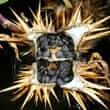Background
- Hyoscyamine is a chemical found in certain plants of the Solanaceae family, including henbane (Hyoscyamus niger), mandrake (Mandragora officinarum), and deadly nightshade (Atropa belladonna). High amounts of hyoscyamine are present in the stems and leaves of young jimson weed (Datura stramonium) plants.
- Extracts of the henbane plant containing hyoscyamine have been used for thousands of years to treat depression. The dried leaves of hyoscyamine-containing plants were smoked for the relief of acute asthma. Jimson weed, which contains high amounts of hyoscyamine, has been commonly used by Native Americans and Native Mexicans as a hallucinogen during various rituals. Hyoscyamine and other belladonna alkaloids were used to treat Parkinson's disease in the early 1900s.
- Hyoscyamine has been used to relieve symptoms of various gastrointestinal disorders, including spasms, peptic ulcers, irritable bowel syndrome, pancreatitis, colic, and cystitis.
- At this time, high-quality human trials supporting the use of hyoscyamine for any indication are lacking. In general, the use of hyoscyamine has been replaced by therapies with fewer adverse effects.
References
- Balikova M. Collective poisoning with hallucinogenous herbal tea. Forensic Sci Int 2002;128(1-2):50-52. View Abstract
- Boumba VA, Mitselou A, Vougiouklakis T. Fatal poisoning from ingestion of Datura stramonium seeds. Vet HumToxicol 2004;46(2):81-82. View Abstract
- Chaptini LA, Janec EM, Seltzer G, et al. Sublingual hyoscyamine spray as premedication for colonoscopy: a randomized double-blinded placebo-controlled trial. Am J Surg 2008;196(1):51-55. View Abstract
- Chew ML, Mulsant BH, Pollock BG, et al. Anticholinergic activity of 107 medications commonly used by older adults. J Am Geriatr Soc 2008;56(7):1333-1341. View Abstract
- Church JM. Warm water irrigation for dealing with spasm during colonoscopy: simple, inexpensive, and effective. Gastrointest Endosc 2002;56(5):672-674. View Abstract
- D'Souza AO, Smith MJ, Miller LA, et al. Persistence, adherence, and switch rates among extended-release and immediate-release overactive bladder medications in a regional managed care plan. J Manag Care Pharm 2008;14(3):291-301. View Abstract
- Foley P. Beans, roots and leaves: a brief history of the pharmacological therapy of parkinsonism. Wurzbg Medizinhist Mitt 2003;22:215-234. View Abstract
- Gehi A, Benatar M, Langberg J. Treatment of pyridostigmine-induced AV block with hyoscyamine in a patient with myasthenia gravis. J Cardiovasc Electrophysiol 2008;19(2):214-216. View Abstract
- Jones JB, Giles BK, Brizendine EJ, et al. Sublingual hyoscyamine sulfate in combination with ketorolac tromethamine for ureteral colic: a randomized, double-blind, controlled trial. Ann Emerg Med 2001;37(2):141-146. View Abstract
- Liu T, Zhu P, Cheng KD, et al. Molecular cloning, expression and characterization of hyoscyamine 6beta-hydroxylase from hairy roots of Anisodus tanguticus. Planta Med 2005;71(3):249-253. View Abstract
- Lynch CR, Khandekar S, Lynch SM, et al. Sublingual L-hyoscyamine for duodenal antimotility during ERCP: a prospective randomized double-blinded study. Gastrointest Endosc 2007;66(4):748-752. View Abstract
- Marneros A, Gutmann P, Uhlmann F. Self-amputation of penis and tongue after use of Angel's Trumpet. Eur.Arch.Psychiatry Clin Neurosci 2006;256(7):458-459. View Abstract
- Miraldi E, Masti A, Ferri S, et al. Distribution of hyoscyamine and scopolamine in Datura stramonium. Fitoterapia 2001;72(6):644-648. View Abstract
- Pavlov A, Berkov S, Weber J, et al. Hyoscyamine biosynthesis in Datura stramonium hairy root in vitro systems with different ploidy levels. Appl Biochem Biotechnol 2009;157(2):210-25. View Abstract
- Wang PS, Levin R, Zhao SZ, et al. Urinary antispasmodic use and the risks of ventricular arrhythmia and sudden death in older patients. J Am Geriatr Soc 2002;50(1):117-124. View Abstract







